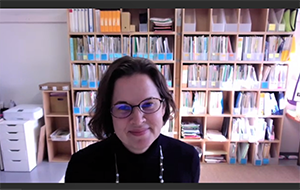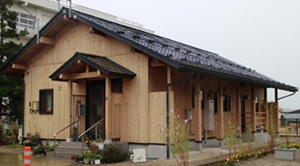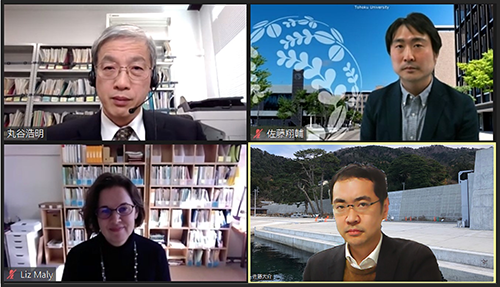2021.3.5
Lessons from the 2011 Great East Japan Earthquake: IRIDeS researchers talk about recovery and passing on disaster memories to future generations (3)
Maruya: Now, Dr. Maly, please.

Dr. Elizabeth Maly
Maly: I wrote Chapter 47 “What is Improved Housing Recovery?- Considered through International Comparisons.” After the Great East Japan Earthquake, the number of houses that needed to be reconstructed was extremely large. The affected areas were diverse in scope and people affected by the disaster had to live in temporary housing for a long time—all of which made the housing reconstruction difficult. In my opinion, good policy measures that support housing reconstruction for disaster affected people share the following two points worldwide: (1) having a high level of flexibility and providing an expanded number of options, and (2) creating a comfortable living environment with high-quality construction (both in design and in building materials). Some housing reconstruction projects after the 2011 disaster fits into these parameters.
As for the first point regarding increased options for disaster-affected people, not only prefabricated temporary housing, but private rental apartments used as designated temporary housing were also provided on a large scale. No new land is necessary for designated temporary housing, and therefore it may be applicable after a disaster occurs in urban areas in the future. As for the second point regarding the creation of a good living environment with quality construction, there were good examples shown by the provision of wooden temporary housing. Approximately 7,000 units were built in Fukushima Prefecture. In Sumita Town, Iwate Prefecture, local construction companies used group subsidies to build temporary wooden houses with local materials. This is a noteworthy example, not only in terms of building materials, but also in terms of the reconstruction process.

福島県会津若松で仮設住宅を
復興公営住宅として再利用
(提供:マリ エリザベス 准教授)
Temporary housing usually falls under the jurisdiction of the prefectural government, whereas disaster recovery public housing falls under the appropriate municipal government. This jurisdictional difference makes it difficult for temporary housing to be converted to permanent disaster recovery housing. However, in Aizuwakamatsu, Fukushima Prefecture, there was a case in where temporary housings were reused as disaster recovery public housing. The U.S. has a similar issue when it comes to silos in government, but a system is being developed to reuse temporary core houses—extending them to build permanent housings. I am interested in the future possibilities for housing conversion.
In the final part of my chapter, I discussed the Sendai Framework for Disaster Risk Reduction 2015-2030 (SFDRR) that is the global disaster risk reduction (DRR) guideline. “Building back better,” which is one of the important concepts of SFDRR, has been discussed in a variety of ways. The SFDRR states that it is important to include diverse stakeholders and to take an inclusive view of recovery. Many countries still need to make significant improvements in their housing reconstruction policies. In Japan, nuclear evacuees still have not found a way to rebuild their lives. However, the housing reconstruction process has been evolving, both in Japan and overseas, providing more comprehensive supports for the lives of disaster-affected people.
D Sato: What do you think about town relocation? There are many old landscapes found within the coastal areas. From a perspective of a historian, I am very concerned that town relocation to higher ground could destroy the townscape that has been constructed through the interactions between people and the natural environment.
Maly: This is an important question that cannot be answered simply. In the U.S., there are measures in place just to buy up the affected area and provide money. The large-scale high land relocation projects after the Great East Japan Earthquake are very rare worldwide. As a result of the relocation to higher ground, residential areas and stores became separate; this makes things much more difficult for people to live, especially for the elderly. In the Philippines, there are cases where relocation has given people sturdy houses but no employment opportunities. Safety alone is simply not enough.
Maruya: I also agree with the idea of considering temporary housing and disaster public housing as a continuum. However, there is always the real problem of quickly finding available land for temporary housing that is needed after a disaster; disaster recovery public housing cannot be built without first securing land that can be permanently used. Land cannot be easily found; and so temporary housing often ends up being built in a temporary space, such as a schoolyard, where permanent housing cannot be built. This is an issue that lies beyond silos in government. If you could propose solutions by introducing inspiring cases from overseas in the future, government may begin to take a realistic interest. I also would like to point out that there were other factors when it came to wooden temporary housing construction: after the 2011 disaster, the supply of prefabricated housings could not meet the need in time and, in addition, there was also a high demand for reconstruction by local companies. I do not think that this was just a simple matter of wooden housing being satisfactory.
Maly: The biggest obstacle to housing reconstruction is the land issue in any country. I also note that trailer houses were used as temporary housing in the disaster area of Atsuma-cho, Hokkaido. It is good that disaster-affected people have more housing options, but - as you pointed out - it is not that simple of an issue. I will keep considering.
Maruya: Finally, let’s talk about the concept of “building back better.” In the affected areas of developing countries, better social and economic development can be expected if a good level of reconstruction can be achieved. However, for a long time, I have been wondering how the term “build back better” can be understood in the context of the 2011 disaster areas. Apart from the municipalities around Sendai, the population of the affected areas is declining—having a negative impact on economic recovery. In Kesennuma and Ishinomaki, for example, values of shipments of manufactured goods have not yet recovered. Onagawa’s population has decreased by half. In this situation, as researchers of IRIDeS that make much account of the SFDRR, how do you think we can build back better within the Tohoku affected areas?
S Sato: At the Miyagi Disaster Prevention and Mitigation Roundtable, we also considered fukko (recovery/reconstruction). While the word is often used by the governments and media, it is not familiar enough of a term to disaster-affected people. However, I cannot think of an alternative word. We tend to think “better” in the context of population numbers or in the economy, but there should be other various evaluation topics—including qualitative ones. We need a place where many people can discuss and agree on how to build back better within the Tohoku disaster areas.
D Sato: There is a very severe reality. However, there are people who have moved into affected areas and have managed to successfully restart with new agriculture, forestry, fisheries, and cultural activities. From a historical timeline, I think that the evaluation is still to come. In terms of historical materials, the former Ishinomaki Cultural Center will be rebuilt in the near future. Regional centers for history and culture are gradually being rebuilt. I believe that, through the conservation of historical materials, relationships with people and the past will be reconstructed—including those who left the area after the disaster. From the standpoint of a historian, who takes a bird’s eye view of events over a long time axis, I would like to continue paying attention to any transformations seen after the earthquake. At the same time, I would also like to keep reconstructing various relationships with people through the use of activities—such as the preservation of historical materials. I will continue to conduct research engaging with the community and will keep thinking.
Maly: The Japanese word fukko has a connotation of making things better than before. There are slight differences in the meaning of “fukko,” “build back better,” and “better fukko.” Everyone wants to make disaster areas better, and so the phrase “build back better” is used frequently. However, different people use the phrase with different meanings and contexts. In some cases, such as relocation to higher ground - even if it is safer in terms of disaster risk - it may not be overall better due to the critical loss of human ties. Thus, I use the term “people-centered housing reconstruction” instead of “building back better.” The phrase “people-centered” is also often used in the SFDRR. Furthermore, the evacuees of the nuclear accident will not be able to return to their hometowns; this is a complex issue that cannot be solved by reconstruction alone and can not be seen as “building back better.” Tsunami and nuclear disaster areas need to be considered separately.
Maruya: While it is difficult to restore prosperity and activeness of the affected areas, it would appear that we need to think about affluence and happiness, focusing on other key concepts such as humanity, culture, community, and exchange. Issues within the disaster areas cannot be easily solved with my expertise alone, which includes economics, governments, and organizations. In the next decade, I hope that we make use of the interdisciplinary connections of IRIDeS in order to find perspectives that will better assist in the improvement of these disaster areas.
(The online discussion was held on January 25, 2021)

